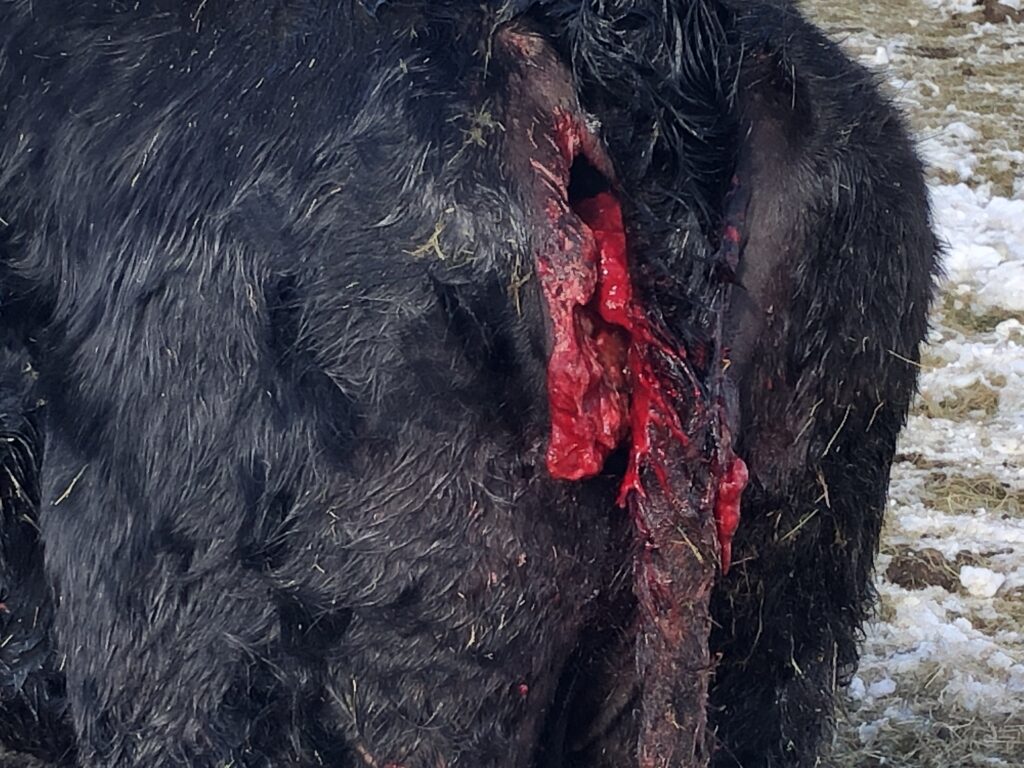Wolves hurt livestock and local communities in the United States and France.
By Michel Meuret, Pierre-Louis Osty and Fred Provenza, Ph.D.s and rangeland scientists.
Grey wolves were reintroduced in the northern Rocky Mountains (NRM) in the mid-1990s, at about the same time wolves discretely came on their own to France, crossing the Alps from Italy. Twenty- five years later, about 1,800 wolves inhabit the NRM while over 500 wolves live in France. The number of wolf packs (72) in the French Alps is similar to that in the Greater Yellowstone Ecosystem.
The main difference, apart from the different landscapes, land tenures, and uses by humans, lies in the number of animals depredated in the two countries: a few hundred per year in the NRM; and more than 10,000 per year, mostly sheep, in France. Since 2008, yearly livestock killings due to wolves in France have grown linearly, reaching 12,515 in 2018.
Why the differences between NRM and France? What went wrong in France? Don’t French wolves have access to wild ungulates as prey in the Alps? Aren’t livestock protected in France?
Certainly, many species of wild prey are abundant in France, but those which escape from wolves adapt their behavior and become more difficult for wolves to catch, especially compared to livestock. Almost all concerned French farmers (about 3,000) have adopted nonlethal protection measures in the Alps: reinforced human presence, guard dogs, secure fences, and compulsory night pens.

Wolf attack in the French Alps. More than 10 ewes and lambs were killed in this single attack, yet very little meat was eaten. Attacks such as this are now common and wolves do not seem to be bothered by close proximity to human dwellings.
During the first 20 years, farmers and hunters were not allowed to use lethal control. In 1992, France signed and implemented the EU Habitat Directive as the legal duty of con- serving outstanding wildlife habitats and species, including the European grey wolf. For the past five years, farmers have been allowed to use lethal control, but only if they are suf- fering verified frequent attacks and request and receive temporary authorization to diverge from the law.
In France, wolves have settled into mosaics of cultivated and natural meadows, hedges, and forest undergrowth. In those locations, livestock are easy and predictable prey and humans do not represent any potential danger to them.
We contend, based on numerous studies, that the differences between NRM and France are due primarily to wolf management. Unlike in the NRM, as a species mostly protected from trapping and hunting in France, wolves have unlearned to associate livestock with humans and humans with danger.

Great Pyrenees dogs on duty in the Southern French Alps. Dogs are on the alert for wolves 24 hours a day. They often risk their lives to protect the flock, as humans generally are not allowed to use lethal means of control. BELOW: A meeting of breeders, herders, scientists and national park officials in the Cevennes Mountains. Direct exchanges about livestock and wolves are essential for local, national and European authorities to better consider how to address wolf depredation
Wolves are smart, opportunistic, and very adaptable. One sign of adaptation: half of successful wolf attacks now take place during the day in France, notwithstanding the constant presence of dogs and regular if not constant presence of humans.
Another sign: wolf attacks are still occurring on high mountain pastures, but there are ever more frequent attacks in valleys and plains. Attacks occur in virtually all seasons in regions without much snow, and in the immediate vicinity of farms, houses, towns, and frequented roads.
The toll on livestock and farmers is great, but that is only part of the story. The rest of the tale is embedded in the physical and emo- tional fabric of livestock, livestock breeders, herders, and local communities throughout the Alps. To the eyes of Antoine Le Gal, sheep breeder and experienced herder in Provence and the Alps, the costs of predation by wolves are far more than livestock losses:
“Herding in the presence of wolves is an extra workload, a stressful situation, but also a recurrent feeling of failure and guilt. This summer, my stress level was reinforced by the fact that I suffered attacks by particularly bold wolves. One evening, my sheep had been in the electrified night pen for an hour, it was dark, the female dog barked, I left the shepherd’s cabin, there were two wolves 20 meters from the door and also 20 meters from the night pen. I went to take my rifle in the cabin, and I chased them for a quarter of an hour on the mountainside. I thought I scared them off. Well, not exactly. The next day, at the same time, they were back! I had to sleep, not in the main room, but in the kitchen, next to the door, and along with my rifle. Many of us, and each year more and many more of us, have to go through this kind of situation. Not only in the high mountains at summer, but also in the valleys and plains in autumn and spring.

“When we count dead bodies, eventually after taking our knife to finish off sheep that have been too seriously injured, what are we counting, actually? We count animals that, most often, we have helped birth. Which we accompanied, them and their mothers, every day. We knew them and they knew us too. Some of the bodies had names, in addition to the mandatory ID numbers. Some of them, when called, answered to their names. So they’re not numbers, percentages of herds, or even, as I’ve heard, ‘legs on feet.’ They are living, intelligent, active beings. Above all, we must—that is our job— offer them a decent life, or even if possible a pleasant and rich life. When we sometimes hear: ‘What are breeders complaining about? They are refunded for the damage caused by wolves,’ it’s absolutely revolting!”

Protest march by farmers against wolf threats during the Tour de France bike race crossing the Alps
Due to wolves, too many tasks and talents are required from farmers, thinks Sebastien Vedrines, a young sheep farmer on a mile- stone plateau in south-central France: “One morning, I discovered some guts that went over the thistles on the pasture. There was one of my young sheep with half of her belly hanging down, and her legs bleeding. And that’s some- thing to say! I know it’s very hard for us to tell, but…if you want the wolf…okay, it’s very beautiful, a wolf, you can make nice photos…but you also have to show to people the other side of the facts!


“We can’t work around the farm during the day, stay watchful against wolves on pastures at night, and have a family life. If, to be a shepherd, you have to become…masochist, insomniac, sniper, with a penchant for illegal- ity…I lack all these qualities for sure! I’m willing to have one or two, try for a third, ha-ha [desperate laugh]…it’s better for us to be single too, I forgot about that. No, we can’t follow this!”
Jacqueline Dupenloup, the Mayor of Saint-Alban-des-Villards, a small alpine village from the Northern French Alps, confronted with wolves and their management, explains how predation impacts her valley much more widely than only livestock losses for farmers and herders:
“I am neither a livestock farmer, nor a shepherdess. I am the mayor of a small village in the Alps—Savoy, France—with responsibilities for managing the municipality, the local alpine landscape, and the local community. Here, more than 20 years ago the wolves came back. In our mountainous and narrow valley, sheep from three local farms are grazed from early May to late October on pastures made of mosaics of natural meadows and forest undergrowth. Last year, despite livestock guard dogs and fences, they suffered more than 15 attacks by wolves, sometimes a few meters from the village, with a total of nearly 90 mother sheep and lambs killed. At the end of June, local flocks are joined by other flocks that come by trucks from Provence to our high mountain pastures for the summer. They were also attacked by wolves several times.
“I can only repeat this sentence heard from a farm advisor or perhaps a shepherd: ‘The wolf is unthinkable…’ Indeed, the wolf is unthinkable. What a paradox: On a planet where people don’t hesitate to plunder natural resources to enrich the wealthy, with consequences that include degraded biodiversity, we should admit that a super-predator and symbol for biodiversity calls into question millennia of shepherding, a practice that is among the most respectful of the environment on Earth.
“It would then be necessary to admit that herders, men and women, must now be equipped with guard dogs, as well as fences two meters high, electrified when possible, and should also become watchful, day and night. In France, as these practices have been proven to be poorly effective in preventing wolf predation, herders should be allowed to get a hunting license, learn to use rifles and become security guards instead of herders. What other profession is framed by such constraints?

In the Alps, shepherds guide herds along daily grazing circuits that stimulate the animals’ appetites for plant diversity, while enhancing biodiversity and producing lamb meat. This is a full-time job. The added task of repelling wolves is unbearable. BELOW: Wolf attack near Jacqueline Dupenloup’s village of Savoy: 23 lambs and ewes were killed. This attack occurred the day after sheep arrived from the plain by truck. Before going to higher mountain pastures, they were first grazed near the village under the care of a shepherd and his guard dogs, in a pasture surrounded by electrified fence

“Can we imagine the constraints and conflicts imposed by wolves on municipalities, on their landscapes, most of them public lands, when challenged to manage impossible cohabitations, between wolves and livestock, guard dogs and bikers or hikers, high fences and village inhabitants?
“Behind the iconic image of a wonderful wild large carnivore, reality imposes itself: in our country, wolves attack more and more often in the presence of humans, during daytime, some- times in the outskirts of villages. They thwart the vigilance of guard dogs, and do not care much about electrified fences. In some cases, they slaughter entire groups of animals, killing to kill, condemning farmers, herders, and even sometimes the mayor, to euthanize half- devoured sheep or goats.
“In France, will our land-management policies shape the future only for urbanized areas with our alpine valleys intended to become merely pleasant recreational areas for city dwellers? And, if so, how can this role be played in alpine landscapes that have less plant and animal biodiversity and no more horizon for hikers, as the lack of herding due to wolves generates rapid and widespread encroachment of shrubs and trees?”
And so, people in France are at the stage Chance Gowan described in his article “Are Wolves Really the Problem” in the Summer 2019 issue of RANGE magazine: wolves have shifted their attention from other wild prey species to domestic livestock and they now show little fear of humans. As Gowan concludes, “Let’s never forget that we also owe the people of rural America the opportunity to protect themselves, their families, their live- stock and their livelihoods.” The same is true in France. As Jacqueline Dupenloup emphasizes, “For us, the wolf is unthinkable and untenable.”
Michel Meuret, animal ecology scientist, coordinates a researchers’ network in France dealing with coadaptation between predators, humans, and other animals. Contact: michel.meuret@inra.fr. Pierre-Louis Osty, field agronomist, raised on a cattle farm, devoted his career to studying the technical systems of livestock farming in relation to landscape dynamics. Fred Provenza, behavioral ecologist, directed an award-winning research group at Utah State University. His latest book, “Nourishment: What animals can teach us about rediscovering our nutritional wisdom,” was published by Chelsea Green in 2018. Contact: fred.provenza@aggiemail.usu.edu.
See “Are Wolves Really the Problem?” by Chance Gowan by clicking here




There are several great ” baits ” to use on preditor pests.
BTW, they are more effective in most cases than using lead on things that all resemble wild dogs w a dangerous killing nature to em.
It’s likely Illegal according to the Bill of Rights and the Articles of the Constitution for the govt to introduce things like wolves that are a danger to humans in those areas of wolf turnouts.
This having to close public schools for sometimes weeks at a time when the wolf packs are in the New Mexico towns Sucks. MO.
Just make sure to Kill anything that looks like a wild dog.
No exceptions